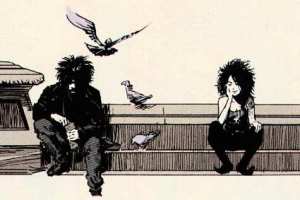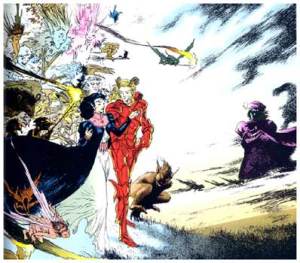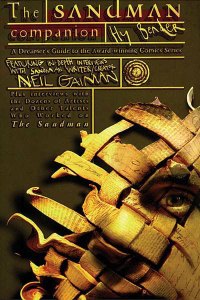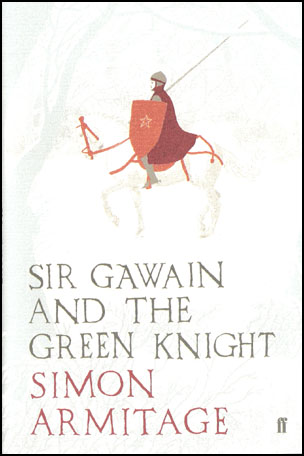Highly Recommended – The Sandman by Neil Gaiman
 I went through a comic buying phase in the early nineties, influenced by a housemate at college. We focussed almost exclusively on output from the DC Vertigo label: Hellblazer, Swamp Thing, Doom Patrol, Shade The Changing Man and Tank Girl (the exception). I still have a stack of the original comics up in the loft somewhere, they’re probably worth a mint now (perhaps less in the case of Shade the Changing Man). As a teen, I enjoyed the subversion of what I’d thought of as a children’s format, with fantastic, adult themes. By far my favourite then, and one of the few to withstand the gradual honing of my critical faculties since, is Neil Gaiman’s Sandman cycle. I was a little late to the party and only started buying my own copies around season three but my housemate had the graphic novels for Preludes and Nocturnes and The Doll’s House and I was hooked from the first issue.
I went through a comic buying phase in the early nineties, influenced by a housemate at college. We focussed almost exclusively on output from the DC Vertigo label: Hellblazer, Swamp Thing, Doom Patrol, Shade The Changing Man and Tank Girl (the exception). I still have a stack of the original comics up in the loft somewhere, they’re probably worth a mint now (perhaps less in the case of Shade the Changing Man). As a teen, I enjoyed the subversion of what I’d thought of as a children’s format, with fantastic, adult themes. By far my favourite then, and one of the few to withstand the gradual honing of my critical faculties since, is Neil Gaiman’s Sandman cycle. I was a little late to the party and only started buying my own copies around season three but my housemate had the graphic novels for Preludes and Nocturnes and The Doll’s House and I was hooked from the first issue.
At first, I was drawn in by the phantasmagoric feel of the early episodes: occultists invoking ancient rites to summon beings of unknown power; dangerous games played for high stakes with the legions of hell; bloody carnage in American diners (a good few years before Tarantino appropriated the image); and best of all, anthropomorphic representations of human traits (Dream, Desire, Death, Despair) who dress like fans of the Cure (proper term: Gothomorphic? RobertSmithomorphic?). Preludes and Nocturnes is a very dark opening to the Sandman story. Gaiman has said that he felt compelled to stay close to the horrific expectations of Vertigo readers in the early days, as he established the comic and its readership. From the start though, it’s clear that Gaiman’s ambitions go way beyond the confines of contemporary gothic horror.
Preludes and Nocturnes is a very dark opening to the Sandman story. Gaiman has said that he felt compelled to stay close to the horrific expectations of Vertigo readers in the early days, as he established the comic and its readership. From the start though, it’s clear that Gaiman’s ambitions go way beyond the confines of contemporary gothic horror.
The Sandman himself (or Dream, or Morpheus, or Oneiros, or a host of other names from alternative folk traditions – which perhaps already starts to suggest the ways in which Gaiman utterly transcends the narrow confines of the pulp comic-book genre) is a compelling character: proud and aloof, governed by his sense of duty and the trappings of his office as the King of Dreams. But he’s also a bit of a romantic: unforgiving, brooding and prone to spells of thunderous gloom when given the heave-ho by his latest love interest. All the makings of the tragic greek hero then, albeit one with a penchant for the Sisters of Mercy and a few tricks up his sleeve by virtue of being one of the Endless, which is to say both very powerful and immortal. Naturally this means he can’t die, but the less-well explored characteristic also applies: he’s been around for a long time already, he’s got history.
Gaiman uses this premise as a jumping off point for visiting his contemporary urban setting, with overspill from Dream and the realms of the rest of the Endless, while framing the whole in a vast historical and mythical (Mystorical?) back-story, featuring such diverse characters as Augustus Caesar, William Shakespeare, Marco Polo, Orpheus, Calliope, Loki Skywalker, Robin Goodfellow, Lucifer, Cain and Abel as well as an array of Gaiman’s own imaginings from the worlds of Earth, Dream, Faery and beyond. Story arcs may start in the present, but the narrative jumps between realms and epochs, making for a fantastic yet mystorically informed reading experience. Morpheus is only occasionally the central protagonist in the various strands: more often he is depicted pursuing his own interests in the background and at times he’s off-screen almost entirely, interceding briefly at some crucial point in the tale to assert the rules or restore balance to the Dreaming.
While this scope is hinted at beforehand, it is in episode 19 – A Midsummer Night’s Dream – where the series really starts to take off. A standalone piece, it recounts the occasion when Will Shakespeare’s travelling theatre company perform the eponymous play on the Sussex Downs for a very exclusive audience: Oberon, Titania and the rest of the Faery court. Shakespeare owes this performance to Morpheus, who sits in the royal box with the Faery King and Queen gauging their reaction. Memorably, in response to prompting from Oberon, Morpheus says ‘Oh, but it is true. Things need not have happened to be true. Tales and dreams are the shadow-truths that will endure when mere facts are dust and ashes and forgot’, touching on one of the cornerstone themes of the Sandman. Sure enough as the night progresses, the boundaries between actors and audience start to break down, echoing the transition from historical reality to myth. The episode attracted much attention at the time, winning the World Fantasy Award for best short story (1991 – the first and last time that a comic book has done so) and for me, it is a defining moment in the Sandman series, simultaneously breaking with the traditions of the genre, while giving Gaiman the confidence and wider audience, to head off into the unknown.
Freed from the conventions of the medium, Gaiman sets about addressing all the really big themes: responsibility, change, the passage of time, life, death, the stories we tell to remember and make sense of it all. In fact everything that makes us human, as embodied by an immortal dream king who, in Gaiman’s own words ‘realises one must change or die, and makes his decision’. This story arc, set in motion from book one, is finally concluded seventy odd episodes and a multitude of detours later, when the decision is made and the ramifications are only just becoming clear. This is impressive enough for a monthly publication, where the author can’t go back and tinker with earlier installments, but Gaiman continually ups the ante, weaving in endless plot / character / thematic strands over the course of the series, tieing them all up by the end in remarkably uncontrived ways: quite some achievement!
The binding agent throughout is Gaiman’s talent for creating scores of memorable characters, and imbuing them with genuine warmth, humanity and hope, despite the darkness that threatens to engulf them. Perhaps the best example of this is Morpheus’s older sister Death, possibly the most upbeat, sassy and downright sexy depiction of that darkest of all human traits. The polar opposite of the now legendary skeletal figure in black cowl with a big curvy knife, she has long since accepted her lot in death and, while she takes her responsibilities very seriously indeed, never lets it get her down (in marked contrast to Morpheus).  In one particularly fine early episode – The Sound of Her Wings – Death berates Dream for moping about and takes him on as work-shadow for the day, reminding Morpheus that he’s not the only one with responsibilities, and perhaps triggering the events that lead circuitously to the eventual denouement sixty episodes later.
In one particularly fine early episode – The Sound of Her Wings – Death berates Dream for moping about and takes him on as work-shadow for the day, reminding Morpheus that he’s not the only one with responsibilities, and perhaps triggering the events that lead circuitously to the eventual denouement sixty episodes later.
Of course, pictures are an integral part of any comic book and in my view the format suits Gaiman much more than prose writing, which perhaps goes some way to explaining his mixed output in the more traditional form. Not only do the beautifully rendered storyboards bring colour and life to his fantastic creations, they bypass the need for elaborate description, turning protagonists into actors on a boundless stage. This allows Gaiman to direct, emphasising action, emotion and voice: colloquial and lyrical, throwaway and profound. A word too about the unique and consistently excellent cover art collages by Dave Mckean, a fitting wrapper for each month’s instalment and nearly as eagerly anticipated as the content itself.
I’ll stop gushing now. You get the idea. Gaiman was incredibly ambitious in attempting a story arc of this magnitude, when he’d initially only been commissioned by DC for a few episodes. The early chapters are a little rough around the edges but that early vision paid off once the series was established, allowing Gaiman the freedom to construct an intricate weave of narrative threads around his ensemble cast, cross-stitching to create a patchwork of interconnected stories. Only when we’ve finished, briefly resisting the urge to go straight back to the start and read it all over again, can we step back and see the whole piece in its glorious entirety: a story about stories and how they shape our lives. A resplendent eider-down, glittering brilliantly across the firmament, under which Morpheus sleeps, perchance to dream.
Alright, a bit more gushing then…. I’ve finished now though. Go on, read it. Then read Hy Bender’s indispensible source book, featuring extensive interviews with Gaiman and a chapter by chapter lit. crit. of the series. Not forgetting the Gaiman authored spinoffs written later or during, including Death – The High Cost of Living, The Time of Your Life, Dream Hunters and Endless Nights.
See also Paul Smith’s recent piece about Morpheus. There’s a more in-depth analysis of the principal characters at the Book Smugglers but here-be-spoilers, so I haven’t provided the link.
Finally, for the musically inclined, I discovered that the early output of His Name Is Alive – Livonia and particularly Home Is In Your Head – provide the perfect Sandman soundtrack: unsettling, ethereal, other-wordly and enchanting. (See also Filigree and Shadow – by This Mortal Coil.)
No comments yet.








Leave a comment